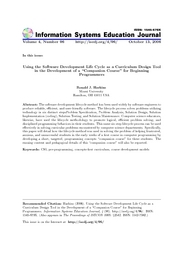Volume 4
Volume 4, Number 96 |
October 13, 2006 |
Abstract: The software development lifecycle method has been used widely by software engineers to produce reliable, efficient, and user-friendly software. The lifecycle process solves problems utilizing technology in six distinct steps…Problem Specification, Problem Analysis, Solution Design, Solution Implementation (coding), Solution Testing, and Solution Maintenance. Computer science educators, likewise, have used the lifecycle methodology to promote logical, efficient problem solving, and disciplined programming behaviors in their students. This same six step lifecycle process can be used effectively in solving curricular problems encountered by computer science departments. Specifically, this paper will detail how the lifecycle method was used in solving the problem of helping frustrated, anxious, and unsuccessful students in the early weeks of a first course in computer programming by developing a short, targeted, programming concepts "companion course" for these students. The ensuing content and pedagogical details of this "companion course" will also be reported.
Keywords: CS0, pre-programming, concepts-first curriculum, course development models
Download this issue: ISEDJ.4(96).Harkins.pdf (Adobe PDF, 8 pages, 382 K bytes)
Preview the contents: Harkins.j.txt (ASCII txt, 24 K bytes)
Recommended Citation: Harkins (2006). Using the Software Development Life Cycle as a Curriculum Design Tool in the Development of a "Companion Course" for Beginning Programmers. Information Systems Education Journal, 4 (96). http://isedj.org/4/96/. ISSN: 1545-679X. (A preliminary version appears in The Proceedings of ISECON 2005: §2542. ISSN: 1542-7382.)
